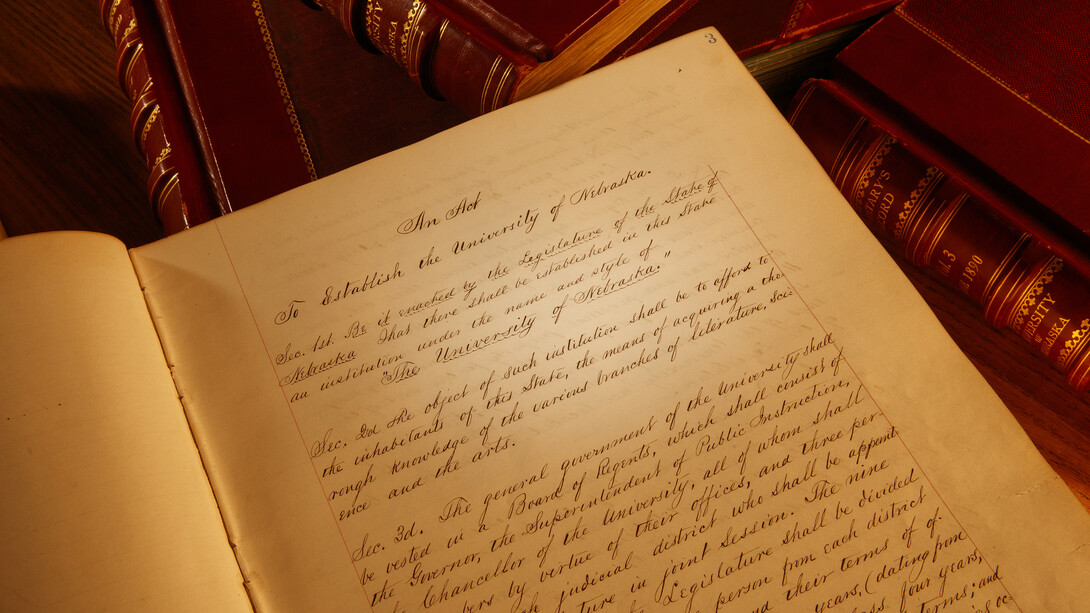
The charter that established Dear Old Nebraska U 150 years ago this week was approved in an incredible feat of legislative efficiency. The seminal document also broke new ground for the Morrill Act and can trace its roots to Thomas Jefferson.
The legislative act will be celebrated as part of the University of Nebraska–Lincoln’s Charter Week festivities, which open today. Here are a few facts (and maybe a few legends) every Husker should know concerning the document that set the university’s foundation.
Not the first
In 1855, acting Governor T.A. Cumming asked the Nebraska territorial legislature to establish a university. During the course of the next decade, more than two-dozen charters were issued to create “Nebraska University” in towns across the state. These proposals were so frequent that the legislature had blank charters printed to give out to developers as needed. None of these early charters were successful.
Location set in 1867
An act passed in 1867 set Lincoln as the capitol city. The act also stated that the university would be in Lincoln and that, “the State University and State Agricultural College shall be united as one educational institution.” To further establish the importance of Lincoln, the 1867 act also placed the penitentiary and insane asylum in the new capitol city.
Approved in Omaha
Nebraska’s state university did not exist until the first state legislature met in Omaha in 1869. In a flurry of activity on Feb. 15, 1869, Nebraska’s then two-house legislature unanimously approved the university charter and sent it to the governor to be signed. States had three years from statehood to accept provisions of the Morrill Act — which granted to land to states that could be sold or leased to provide funds for universities — and two more years to construct a building and open a university. Nebraska met both deadlines. The legislative act that formed the university’s charter allowed Nebraska to claim some 136,080 acres for the university under the terms of the Morrill Act.
Inspired by Wolverines and a Founding Father
The bill that established the university was written by August Harvey, a state legislator from Nebraska City. In creating the bill, Harvey drew inspiration from the charter of the University of Michigan, the most firmly established of state universities at that time. Michigan’s 1837 charter was based on a document written by U.S. Circuit Judge Augustus Woodward, who had conferred with Thomas Jefferson as the University of Virginia was being planned.
Expanding the Morrill Act
As written, the University of Nebraska charter established an institution open to all inhabitants of the state — not just citizens or youth. This view — that the university “shall be to afford to the inhabitants of the state the means of acquiring a thorough knowledge of the various branches of literature, science and the arts” — broadened the scope of the Morrill Act, making the University of Nebraska open to all regardless of age, sex, color or nationality. From the very first day of classes, women have been enrolled along with men.
Original organization
Control of the university was placed in the hands of 12 regents — nine representing the state’s judicial districts, alongside the governor, state superintendent of public institutions and NU’s chancellor. The nine were initially selected by the governor, but appointed by the legislature thereafter. In an 1877 revision to the state constitution, the number was reduced to six regents who are elected by the public. The first board met June 3, 1869 to establish organization and plan for the first university building. They met a second time in September 1869 to lay the cornerstone of University Hall, but did not convene again for 15 months.
First college
The charter outlined the establishment of six “departments,” which included a College of Ancient and Modern Literature, Mathematics and the Natural Sciences; College of Agriculture; College of Law; College of Medicine; College of Practical Science, Civil Engineering and Mechanics; and College of Fine Arts (which could only be established when the annual income of the university exceeded $100,000). The first department, the College of Ancient and Modern Literature, Mathematics and the Natural Sciences was renamed the College of Literature, Science and the Arts, and opened in fall 1871. The college, renamed the College of Arts and Sciences, is the university’s largest, enrolling more than 4,000 undergraduates and nearly 1,000 graduate students. It includes more than 800 faculty in 59 departments and units, with 34 majors and 59 minors. The college boasts more than 45,000 alumni.
Available for review
As the university celebrates the its founding charter this week, all Huskers are encouraged to read the document that created Dear Old Nebraska U. The charter is available for review online or in person at the University Archives and Special Collections, and in the records room at the State Capitol.
Editor’s Note — Information for this story was gathered from the original university charter, “Prairie University” by Robert Knoll, and “Dear Old Nebraska U: Celebrating 150 Years” by Kim Hachiya and Craig Chandler.







